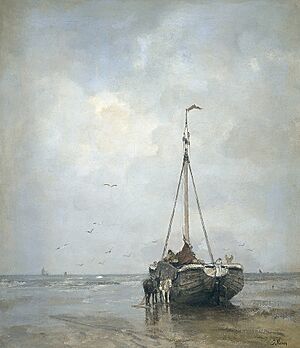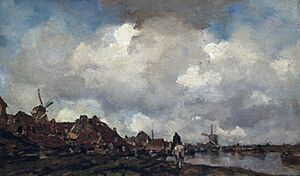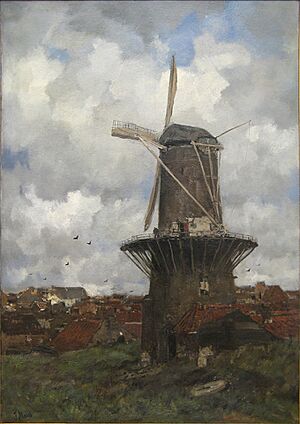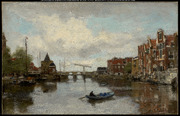Jacob Maris facts for kids
Quick facts for kids
Jacob Maris
|
|
|---|---|

Jacob Maris by Matthijs Maris, ca.1857
|
|
| Born | August 25, 1837 |
| Died | August 7, 1899 (aged 61) |
| Nationality | Dutch |
| Known for | Painting |
Jacob Henricus Maris (born August 25, 1837 – died August 7, 1899) was a famous Dutch painter. He was part of a group called the Hague School of painters. His brothers, Willem and Matthijs, were also painters in this group.
Jacob Maris was seen as one of the most important Dutch landscape painters of his time. He was very influential in the late 1800s. His first art teacher was J.A.B. Stroebel, who taught him from 1849 to 1852. Jacob Maris is well-known for his landscape paintings. He also painted portraits of the Dutch royal family with his brother Matthijs. One of his famous landscape paintings is Ship on the Scheveningen Beach.
Contents
Jacob Maris: An Artist's Journey
Jacob Maris was born in The Hague, a city in the Netherlands. When he was twelve, he started taking art lessons. Later, he joined the Hague Academy of Art, a top art school. He studied there from 1850 to 1853.
An art dealer noticed Jacob's talent. This helped Jacob get a job in the studio of Hubertus van Hove. There, Jacob painted scenes of rooms and everyday life. Van Hove became Jacob's mentor and teacher.
Learning and Traveling
When Van Hove moved to Antwerp, Jacob, who was nineteen, went with him. This partnership continued until Jacob's brother Matthijs received a special grant. Matthijs then joined Jacob in Antwerp. They rented a studio together, which also had space for their friend Lawrence Alma-Tadema.
The brothers took lessons at the Antwerp Academy. They also managed to sell some of their paintings. After this, Jacob traveled through Germany, Switzerland, and France in 1861.
Success and Return Home
Like many artists from the Hague School, Jacob Maris became very successful. His paintings were popular in the Netherlands and other countries. He sold many of his artworks to private collectors. These collectors were mostly in the United States and Scotland.
In 1857, Jacob Maris returned to The Hague. Matthijs stayed in Antwerp for another year. Then, he also came back to The Hague and shared a studio with Jacob again. They earned money by copying eight royal portraits. This allowed them to visit Oosterbeek. There, they met other artists who would become important members of the Hague School.
The brothers also went on a study trip together. They visited Germany, Switzerland, and France. When their money ran out, they moved back in with their parents. Jacob took more lessons at the Hague Academy of Art. In the summer of 1864, Jacob visited Oosterbeek again. He might have also gone to Fontainebleau and Barbizon, famous art spots.
Developing His Unique Style
From 1865 to 1871, Jacob lived in Paris. He returned to the Netherlands when the Franco-Prussian War started. Back in The Hague, he became a strong landscape painter. He painted rivers, landscapes with windmills, and beach scenes with fishing boats.
His painting style became bolder and broader. He used more muted colors to show the atmosphere of clouds. His work has been compared to famous 17th-century Dutch painters. These include Jan van Goyen, Jacob Van Ruisdael, and Johannes Vermeer.
People described his painting method like this: He would paint first and then draw details. He applied paint thickly, building it up. He would work on it until the colors created a beautiful harmony. Only then would he add figures with quick, thin brush strokes. The final touch was always masterful, making the whole painting strong.
A critic named M. Philippe Zilcken said that no painter showed the misty, light-filled air of Holland better. He captured the distant horizons blurred by haze. He also perfectly showed the grey but bright weather of Holland.
Influence and Later Life
In 1871, Maris joined the Pulchri Studio, an art society. He held several important roles there. He only started to gain fame in the Netherlands after 1876. By 1885, he was a celebrated painter. As a leader of the Hague School, he had a huge impact on other artists. However, he only had a few students, like Willem de Zwart and possibly Bernard Blommers.
When he was in his sixties, Jacob Maris started to suffer from asthma. He also gained a lot of weight. His doctors advised him to visit a spa in Karlsbad. Sadly, he died there suddenly on August 7, 1899. He was buried in The Hague.
Gallery






